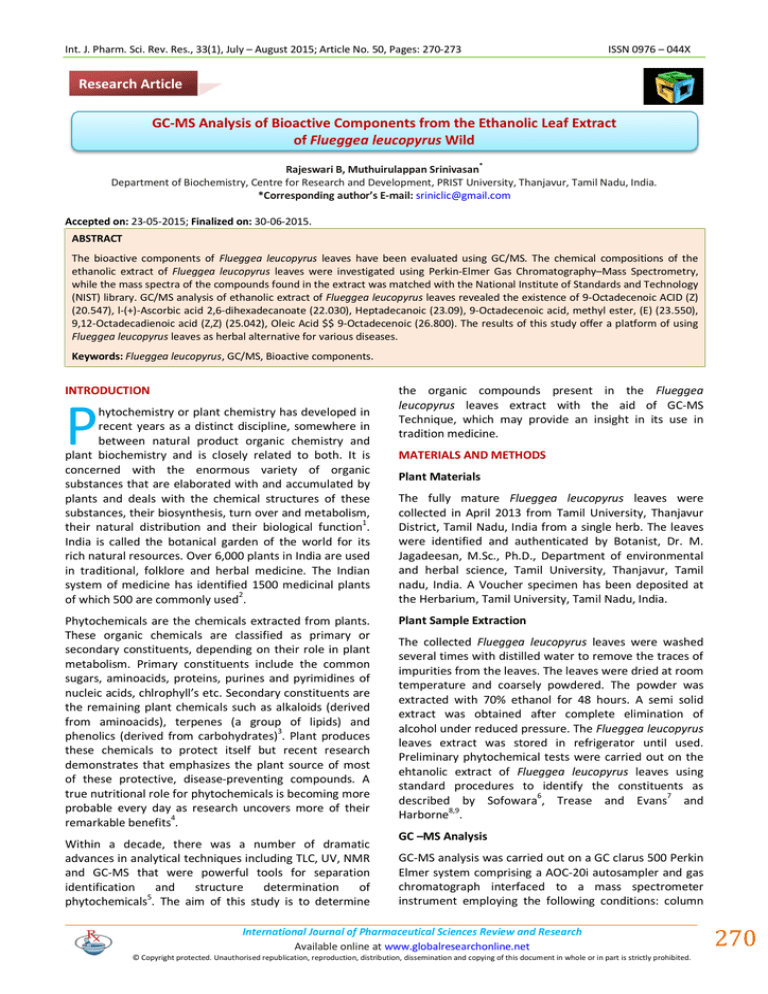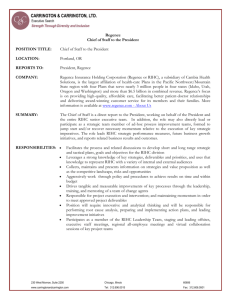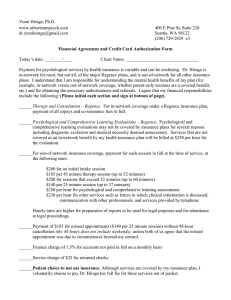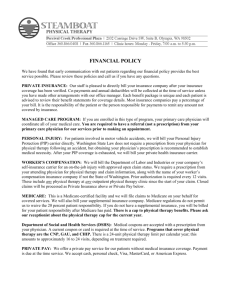Document 13310530
advertisement

Int. J. Pharm. Sci. Rev. Res., 33(1), July – August 2015; Article No. 50, Pages: 270-273 ISSN 0976 – 044X Research Article GC-MS Analysis of Bioactive Components from the Ethanolic Leaf Extract of Flueggea leucopyrus Wild * Rajeswari B, Muthuirulappan Srinivasan Department of Biochemistry, Centre for Research and Development, PRIST University, Thanjavur, Tamil Nadu, India. *Corresponding author’s E-mail: sriniclic@gmail.com Accepted on: 23-05-2015; Finalized on: 30-06-2015. ABSTRACT The bioactive components of Flueggea leucopyrus leaves have been evaluated using GC/MS. The chemical compositions of the ethanolic extract of Flueggea leucopyrus leaves were investigated using Perkin-Elmer Gas Chromatography–Mass Spectrometry, while the mass spectra of the compounds found in the extract was matched with the National Institute of Standards and Technology (NIST) library. GC/MS analysis of ethanolic extract of Flueggea leucopyrus leaves revealed the existence of 9-Octadecenoic ACID (Z) (20.547), l-(+)-Ascorbic acid 2,6-dihexadecanoate (22.030), Heptadecanoic (23.09), 9-Octadecenoic acid, methyl ester, (E) (23.550), 9,12-Octadecadienoic acid (Z,Z) (25.042), Oleic Acid $$ 9-Octadecenoic (26.800). The results of this study offer a platform of using Flueggea leucopyrus leaves as herbal alternative for various diseases. Keywords: Flueggea leucopyrus, GC/MS, Bioactive components. INTRODUCTION P hytochemistry or plant chemistry has developed in recent years as a distinct discipline, somewhere in between natural product organic chemistry and plant biochemistry and is closely related to both. It is concerned with the enormous variety of organic substances that are elaborated with and accumulated by plants and deals with the chemical structures of these substances, their biosynthesis, turn over and metabolism, their natural distribution and their biological function1. India is called the botanical garden of the world for its rich natural resources. Over 6,000 plants in India are used in traditional, folklore and herbal medicine. The Indian system of medicine has identified 1500 medicinal plants of which 500 are commonly used2. Phytochemicals are the chemicals extracted from plants. These organic chemicals are classified as primary or secondary constituents, depending on their role in plant metabolism. Primary constituents include the common sugars, aminoacids, proteins, purines and pyrimidines of nucleic acids, chlrophyll’s etc. Secondary constituents are the remaining plant chemicals such as alkaloids (derived from aminoacids), terpenes (a group of lipids) and 3 phenolics (derived from carbohydrates) . Plant produces these chemicals to protect itself but recent research demonstrates that emphasizes the plant source of most of these protective, disease-preventing compounds. A true nutritional role for phytochemicals is becoming more probable every day as research uncovers more of their remarkable benefits4. Within a decade, there was a number of dramatic advances in analytical techniques including TLC, UV, NMR and GC-MS that were powerful tools for separation identification and structure determination of phytochemicals5. The aim of this study is to determine the organic compounds present in the Flueggea leucopyrus leaves extract with the aid of GC-MS Technique, which may provide an insight in its use in tradition medicine. MATERIALS AND METHODS Plant Materials The fully mature Flueggea leucopyrus leaves were collected in April 2013 from Tamil University, Thanjavur District, Tamil Nadu, India from a single herb. The leaves were identified and authenticated by Botanist, Dr. M. Jagadeesan, M.Sc., Ph.D., Department of environmental and herbal science, Tamil University, Thanjavur, Tamil nadu, India. A Voucher specimen has been deposited at the Herbarium, Tamil University, Tamil Nadu, India. Plant Sample Extraction The collected Flueggea leucopyrus leaves were washed several times with distilled water to remove the traces of impurities from the leaves. The leaves were dried at room temperature and coarsely powdered. The powder was extracted with 70% ethanol for 48 hours. A semi solid extract was obtained after complete elimination of alcohol under reduced pressure. The Flueggea leucopyrus leaves extract was stored in refrigerator until used. Preliminary phytochemical tests were carried out on the ehtanolic extract of Flueggea leucopyrus leaves using standard procedures to identify the constituents as described by Sofowara6, Trease and Evans7 and Harborne8,9. GC –MS Analysis GC-MS analysis was carried out on a GC clarus 500 Perkin Elmer system comprising a AOC-20i autosampler and gas chromatograph interfaced to a mass spectrometer instrument employing the following conditions: column International Journal of Pharmaceutical Sciences Review and Research Available online at www.globalresearchonline.net © Copyright protected. Unauthorised republication, reproduction, distribution, dissemination and copying of this document in whole or in part is strictly prohibited. 270 © Copyright pro Int. J. Pharm. Sci. Rev. Res., 33(1), July – August 2015; Article No. 50, Pages: 270-273 Elite-1 fused silica capillary column (30 x 0.25mm ID x 1µMdf, composed of 100% Dimethyl polydiloxane), operating in electron impact mode at 70eV; Helium gas (99.999%) was used as carrier gas at a constant flow of 1 ml /min and an injection volume of 0.5 µI was employed (split ratio of 10:1) injector temperature 250 °C; ionsource temperature 280 °C. The oven temperature was programmed from 110 °C (isothermal for 2 min), with an increase of 10 °C/min, to 200°C, then 5°C/min to 280°C, ending with a 9min isothermal at 280°C. Mass spectra were taken at 70eV; a scan interval of 0.5 seconds and fragments from 40 to 450 Da. Total GC running time is 36min. The relative percentage amount of each component was calculated by comparing its average peak area to the total areas. Software adopted to handle mass spectra and chromatograms was a TurboMass Ver 5.2.0. RESULTS AND DISCUSSION Plants have an almost limitless ability to synthesize aromatic substances, most of which are phenols or their oxygen substituted derivatives. Most are secondary metabolites, of which at least 12,000 have been isolated, a number estimated to be less than 10% of the total. These substances serve as plant defense mechanisms against, insects and herbivores. Flavonoids exhibit several biological effects such as anti-inflammatory, anti-fungal, anti-hepatotoxic and anti-ulcer actions10. ISSN 0976 – 044X retention time (RT), molecular formula, molecular weight (MW) and concentration (%) are presented in (Table 1 and Fig 1). The prevailing compounds were 9Octadecenoic acid (Z) (20.547), l-(+)-Ascorbic acid 2,6dihexadecanoate (22.030), Heptadecanoic (23.09), 9Octadecenoic acid, methyl ester, (E) (23.550), 9,12Octadecadienoic acid (Z,Z) (25.042), Oleic Acid $$ 9Octadecenoic (26.800). The biological activities listed (Table 2) are based on Dr. Duke’s phytochemical and ethnobotanical Databases by Dr. Jim Duke of the Agricultural Research Service/USDA. In the present study twenty chemical constituents have been identified from ethanolic extract of the plant of Flueggea leucopyrus by Gas Chromatogram- Mass spectrometry (GC-MS) analysis. The presence of various bioactive compounds justifies the use of the whole plant for various ailments by traditional practitioners. However isolation of individual phytochemical constituents and subjecting it to biological activity will definitely give fruitful results. It could be concluded that Flueggea leucopyrus contains various bioactive compounds. So it is recommended as a plant of phytopharmaceutical importance. However, further studies will need to be undertaken to ascertain fully its bioactivity, toxicity profile, effects on the biological system and agricultural products. Identification of Components Interpretation on mass spectrum GC-MS was conducted using the database of National Institute Standard and Technology (NIST) having more than 62,000 patterns. The spectrum of the unknown component was compared with the spectrum of the known components stored in the NIST library. The name, molecular weight and structure of the components of the test materials were ascertained. GC-MS Analysis Nine compounds were identified in Flueggea leucopyrus leaves by GC-MS analysis. The active principles with their Figure 1: Analysis of bioactive compounds in Flueggea leucopyrus leaf by GC MS Table 1: Analysis of bioactive compounds in Flueggea leucopyrus leaf by GC MS Peak R.Time Area% Name of Compound Molecular Formula Molecular Weight 1 3.033 0.52 Imidazole, 2-amino-5-[(2-carboxy)vinyl] C6H7N3O2 153 2 3.165 0.73 1H-Pyrrole, 1-methyl C5H7N 81 3 10.768 0.53 Benzofuran, 2,3-dihydro C8H8O 120 4 16.812 0.29 Dodecanoic acid C12H24O2 200 5 17.531 0.15 Diethyl Phthalate C12H14O4 222 6 19.644 1.33 Tetradecanoic acid C24H48O2 368 7 20.547 0.19 9-Octadecenoic acid (Z) C18H36O2 284 8 20.618 0.54 2,6,10-Trimethyl,14-ethylene-14-pen C20H38 278 9 20.875 0.76 Pentadecanoic acid C15H30O2 242 10 21.133 0.27 Cyclopropanenonanoic acid, 2-[(2-butylcyclopr C7H12 96 11 21.621 0.21 Hexadecanoic acid, methyl ester C17H34 O2 270 12 21.837 2.38 Cyclopentadecanone, 2-hydroxy C8H12O2 140 International Journal of Pharmaceutical Sciences Review and Research Available online at www.globalresearchonline.net © Copyright protected. Unauthorised republication, reproduction, distribution, dissemination and copying of this document in whole or in part is strictly prohibited. 271 © Copyright pro Int. J. Pharm. Sci. Rev. Res., 33(1), July – August 2015; Article No. 50, Pages: 270-273 ISSN 0976 – 044X 13 22.030 19.31 l-(+)-Ascorbic acid 2,6-dihexadecanoate C38H68O8 652 14 23.091 0.82 Heptadecanoic acid C17H34 O2 270 15 23.550 0.18 9-Octadecenoic acid, methyl ester, (E) C18H34 O2 282 16 23.720 2.24 2-Hexadecen-1-OL, 3,7,11,15-tetrame C20H40 O 296 17 23.793 0.33 Methyl stearate C19H38O2 298 18 24.006 15.29 9-Octadecenoic acid C18H34 O2 282 19 24.047 12.40 9,12,15-Octadecatrienoic acid C18H32O 264 20 24.239 23.02 Octadecanoic acid C18H36O2 284 21 25.042 0.31 9,12-Octadecadienoic acid (Z,Z) C18H32 O2 280 22 26.121 0.70 Nonadecanoic acid C19H36O2 296 23 26.121 0.50 Hexadecanoic acid, 2-hydroxy-1,3- C37H74NO8P 691 24 26.800 0.75 Oleic Acid $$ 9-Octadecenoic C18H34O2 282 25 26.911 0.83 Cyclopentadecanone, 2-hydroxy- C12H20 164 26 27.158 4.32 Icosanoic acid C20H40O2 321 27 28.678 6.62 Solanesol C45H74O 360 28 29.573 2.47 1,5,9-Decatriene, 2,3,5,8-tetramethyl C14H24 192 29 30.086 1.10 Glycidol stearate C21H40O3 340 30 31.487 0.90 Bis(2-ethylhexyl) phthalate C24H38O4 390 Table 2: Biological activity of compounds in Flueggea leucopyrus leaf extract S.No. R. Time 1. 19.644 Area% Name of Compound 1.33 Tetradecanoic acid the Molecular Formula Molecular Weight Biological Activity** C24H48O2 368 Antioxidant, Lubricant, Hypercholesterolemic, Cancer_preventive, Cosmetic. 2. 22.030 19.31 l-(+)-Ascorbic acid 2,6dihexadecanoate C38H68O8 652 Anticancer, Antioxidant, Cardioprotective, Antiarthritis, Antiageing, Hypolipidemic 3. 23.091 0.82 Heptadecanoic acid C17H34 O2 270 Antioxidant 4. 23.550 0.18 9-Octadecenoic acid, methyl ester, (E) C18H34 O2 282 Antioxidant, hypocholesterolemic nematicide, pesticide, anti-androgenic flavor, hemolytic, 5Alpha reductase inhibitor 5. 24.047 6. 24.239 12.40 23.02 9,12,15Octadecatrienoic acid C18H32O Octadecanoic acid C18H36O2 264 Antibacterial Antifungal 284 Cosmetic, Flavor, Hypocholesterolemic, Lubricant, Perfumery, Prophetic, Suppository 7. 25.042 0.31 9,12-Octadecadienoic acid (Z,Z) C18H32 O2 280 Antiarteriosclerotic, Antiarthritic, antianaphylactic, Antieczemic, Cancer preventive, antiprostatic, hepatoprotective, Hypocholesterolemic, Metastatic, Nematicide 8. 26.800 0.75 Oleic Acid $$ Octadecenoic 9- C18H34O2 282 5-Alpha-Reductase-Inhibitor, Allergenic, AlphaReductase-Inhibitor, Anemiagenic, Antialopecic, Antiandrogenic, Antiinflammatory, Antileukotriene-D4 (Anti-platelet activating factor), Cancer-Preventive, Choleretic, Dermatitigenic Flavor, Hypocholesterolemic, Insectifuge Irritant, Percutaneostimulant, Perfumery, Propecic **Source: Dr. Duke’s phytochemical and ethnobotanical database (online database) International Journal of Pharmaceutical Sciences Review and Research Available online at www.globalresearchonline.net © Copyright protected. Unauthorised republication, reproduction, distribution, dissemination and copying of this document in whole or in part is strictly prohibited. 272 © Copyright pro Int. J. Pharm. Sci. Rev. Res., 33(1), July – August 2015; Article No. 50, Pages: 270-273 ISSN 0976 – 044X Acknowledgement: The authors are grateful to Dr. S. Velavan, Director, Harman Institute of Science Education and Research (www.harmanresearchcentre.com), Thanjavur, Tamil Nadu for providing necessary facility to complete this work. 5. Roberts JKM, Xia JH. High-resolution NMR methods for study of higher plants, Methods Cell Biol. 49, 1995, 245– 258. 6. Sofowara A. Medicinal plants and Traditional medicine in Africa. Spectrum Books Ltd, Ibadan, Nigeria. 1993, 191-289. REFERENCES 7. Trease GE, Evans WC. Phenols and Phenolic glycosides. In: Textbook of Pharmacognosy. (12th ed.). Balliese, Tindall and Co Publishers, London. 1989, 343-383. 8. Harborne JB. Phytochemical methods, London. Chapman and Hall, Ltd. 1973, 49-188. 9. Harborne JB. Phytochemical Methods. A Guide to Modern Technique of Plant Analysis. London: Chapman and Hall. 1984, 78-210. 1. 2. 3. 4. Harborne JB. Plant flavonoids in biology and medicine: Biochemical pharmacological, and structure–activity relationships. NY, USA: Alan R. Liss. 1986, 15–24. Agrawal OP, Raju PS. Global market of herbal products: Opportunities for Indian Traditional System of Medicine. New Delhi, India, Narcosa Publishing House, 2006, 5-10. Liu RH. Potential synergy of phytochemicals in cancer prevention: Mechanism of action. Journal of Nutrition, 134(12 Suppl.), 2004, p3479S–3485S. Hamburger M, Hostettmann, K. Bioactivity in plants: the link between phytochemistry and medicine. Phytochemistry. 30, 1991, 3864È74. 10. de-Fatima A, Modolo LV, Conegero LS, Pilli RA, Ferreira CV, Kohn LK, de-Carvalho JE. Lactones and their derivatives: biological activities, mechanisms of action and potential leads for drug design. Curr. Med. Chem. 13, 2006, 33713384. Source of Support: Nil, Conflict of Interest: None. International Journal of Pharmaceutical Sciences Review and Research Available online at www.globalresearchonline.net © Copyright protected. Unauthorised republication, reproduction, distribution, dissemination and copying of this document in whole or in part is strictly prohibited. 273 © Copyright pro





